Introduction
Sensory bottles have emerged as invaluable tools for fostering emotional well-being and developmental growth in children, particularly those facing sensory processing challenges. These captivating creations not only offer a soothing experience that can alleviate anxiety but also enhance focus and self-regulation. By engaging multiple senses through a variety of textures, colors, and sounds, sensory bottles become more than just playful objects; they serve as essential resources for learning and exploration.
The creative process of making sensory bottles invites children to participate actively, allowing them to express their preferences while developing fine motor skills. This hands-on interaction not only fuels creativity but also supports cognitive growth, reinforcing the importance of sensory activities across all developmental stages. The versatility of sensory bottles means they can be tailored to meet the unique needs of every child, promoting calmness and engagement in a fun, interactive way.
As the discussion unfolds, various ideas for crafting sensory bottles, essential materials, and safety considerations will be explored, empowering caregivers to integrate these enriching activities into daily routines. Whether for calming moments or educational purposes, sensory bottles stand as a beacon of support for both children and their advocates, making a positive impact on their journey toward emotional and cognitive development.
Benefits of Sensory Bottles for Children
Resourceful containers act as a crucial tool for youngsters, especially those encountering processing difficulties related to sensory experiences. These engaging tools provide a soothing experience that can significantly reduce anxiety and enhance emotional regulation. By providing a tactile and visual experience, these containers engage young ones' attention, encouraging concentration and tranquility during overwhelming moments.
The manipulative quality of these bottles also aids in the advancement of fine motor abilities as young ones twist, shake, and investigate different materials contained within each bottle. This hands-on interaction not only fosters creativity but also encourages cognitive growth as children experiment with different colors, textures, and sounds.
Research emphasizes the significance of experiential exercises in involving all five senses—touch, smell, sight, taste, and sound—as well as the vestibular and proprioceptive systems. Engaging in these sensory exercises can lead to improvements in language skills, social abilities, and self-regulation, making sensory bottles a versatile tool for enhancing overall development.
As one caregiver remarked, 'Sensory experiences soothe my kids like nothing else, and even better, they’re enjoyable!' This sentiment resonates with many parents who incorporate sensory-friendly practices into their daily routines, often finding that the benefits are both noticeable and transformative. In fact, exploratory play is not only beneficial for children with sensitivities; it enhances learning and engagement for all children, making it a valuable addition to any learning environment.
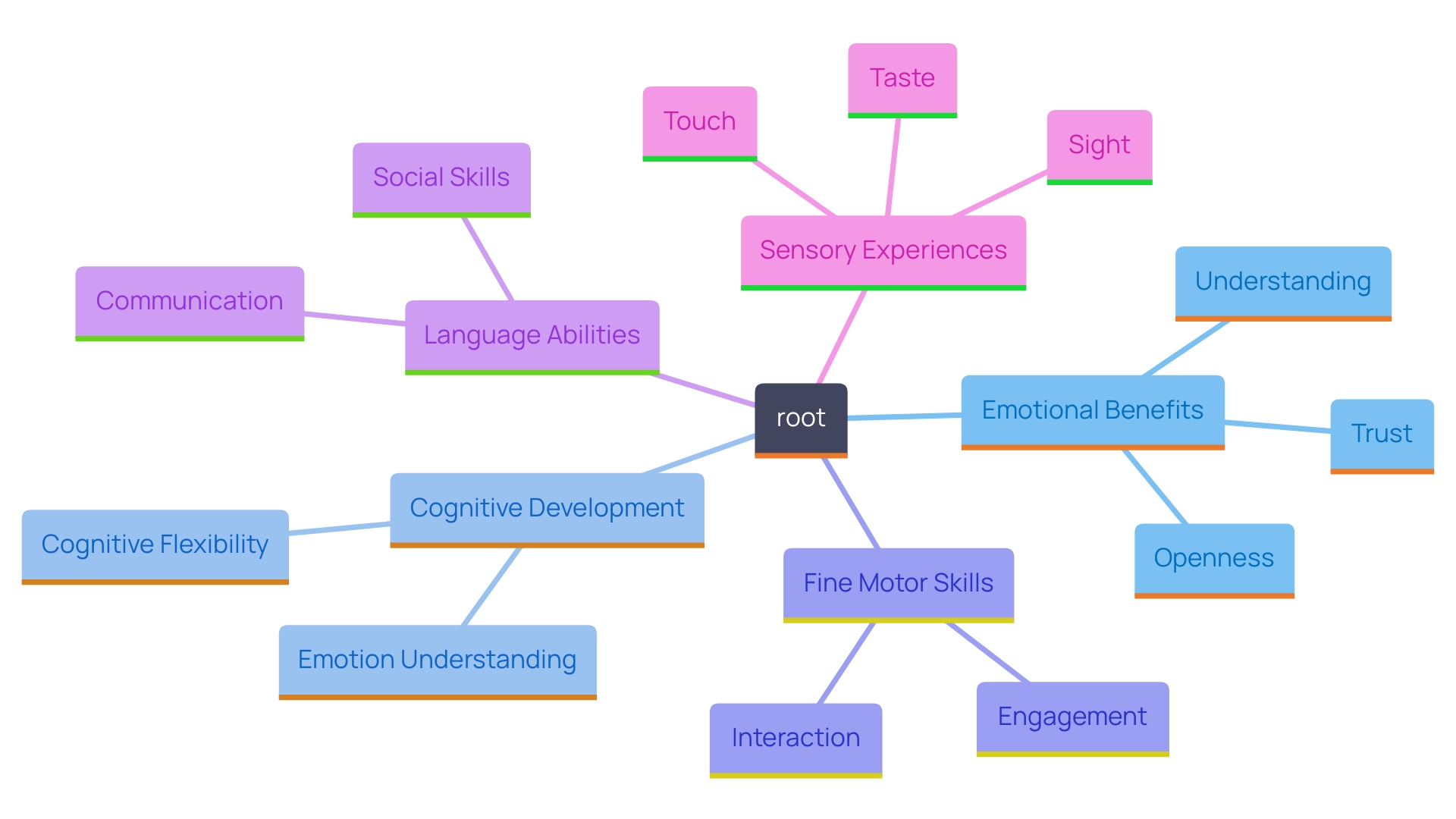
Materials Needed for Sensory Bottles
Making sensory vessels is an interesting and simple task that provides numerous chances for personalization and innovation. Gather the following materials to get started:
- Clear plastic bottles: Recycled water or soda bottles work exceptionally well.
- Fillers: Choose from a variety of options such as water, glitter, beads, rice, or sand. Each material offers distinct experiential qualities, from the visual sparkle of glitter to the tactile feel of sand.
- Optional additions: Enhance the sensory experience further with food coloring, essential oils, or small toys. These items can add colors and scents that stimulate additional senses, making the containers even more intriguing.
- Sealing materials: Use strong glue or tape to securely seal the bottles. This step ensures that the contents remain intact during perceptual exploration.
The process of assembling these materials is not only practical but also serves as an exciting opportunity for young individuals to express their preferences. By permitting them to select their fillers and hues, you cultivate a feeling of possession over their calming container, turning it into a personal and significant instrument for relaxation and concentration.
Sensory bottles can significantly impact children's ability to self-regulate emotions and manage anxiety. Research indicates that perceptual activities engage various systems, including touch, sight, and sound, positively affecting language development, motor skills, and social interactions. Including tactile activities in everyday schedules has shown to be advantageous, offering soothing effects that can improve overall health.
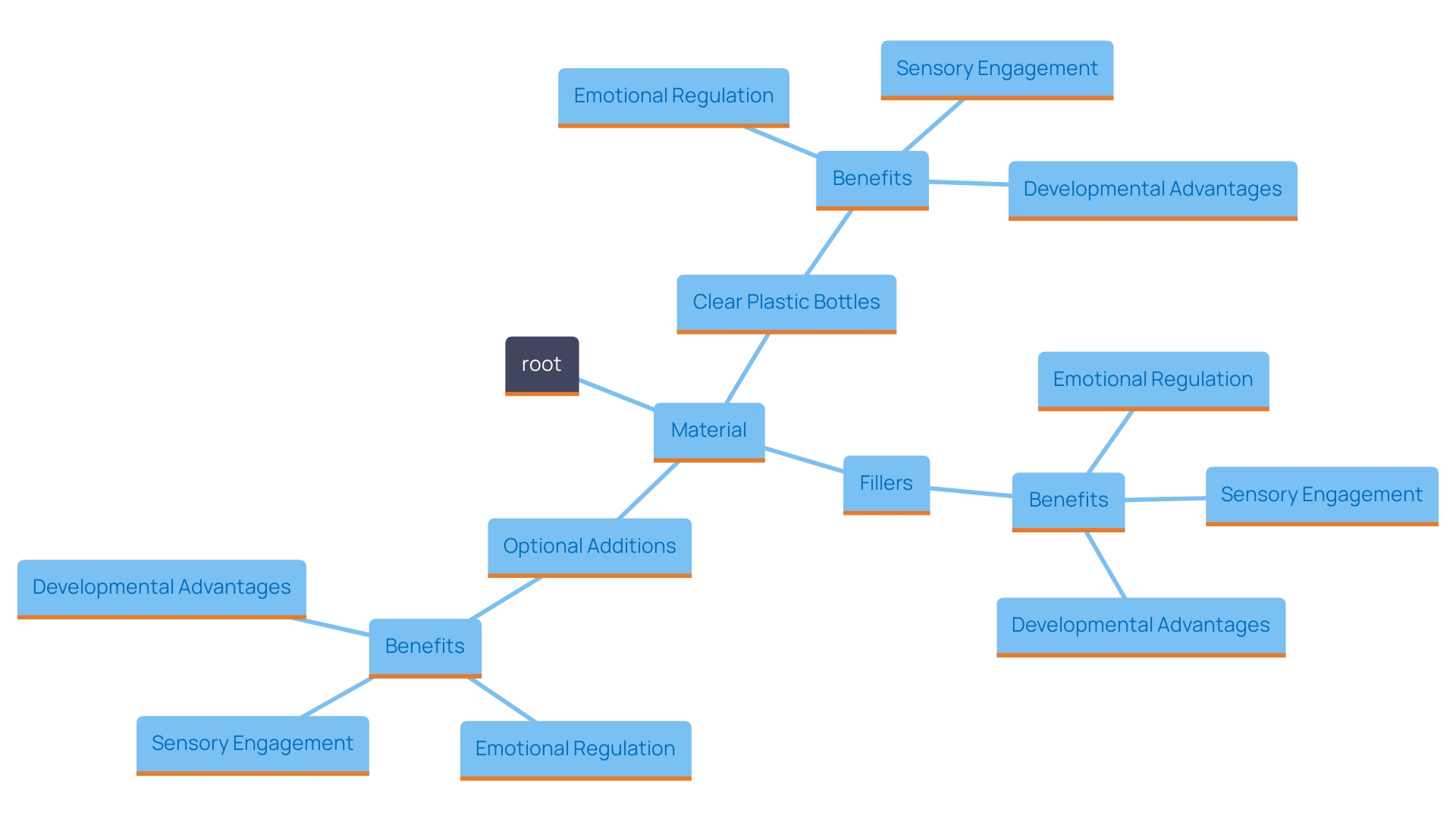
Step-by-Step Guide to Making Sensory Bottles
- Start by selecting a clean plastic container and gently take off any tags to establish a blank surface for your project.
- Fill the bottle approximately one-third full with your selected filler, such as water, sand, or rice. These materials not only provide texture but also improve the tactile experience.
- Introduce additional elements like glitter, beads, or small toys to add visual interest and stimulate curiosity. These elements can capture attention and encourage exploration, which is vital for sensory engagement.
- If you opt for liquids, consider incorporating a few drops of food coloring to create a lively and vibrant effect. This can also help in visual tracking, a skill that's beneficial for developing focus and attention.
- Continue filling the container with water or your chosen liquid, leaving a small air gap at the top. This gap enables the contents to shift effortlessly, forming captivating swirls that can be calming for young ones.
- Fasten the container securely with adhesive or tape to prevent any leaks, ensuring safety during play. A well-sealed container allows children to shake and explore without worry.
- Shake the container gently and watch as the contents swirl and settle, providing a calming visual experience. This tactile activity not only engages sight but also promotes relaxation and can be particularly beneficial during moments of anxiety or overstimulation.
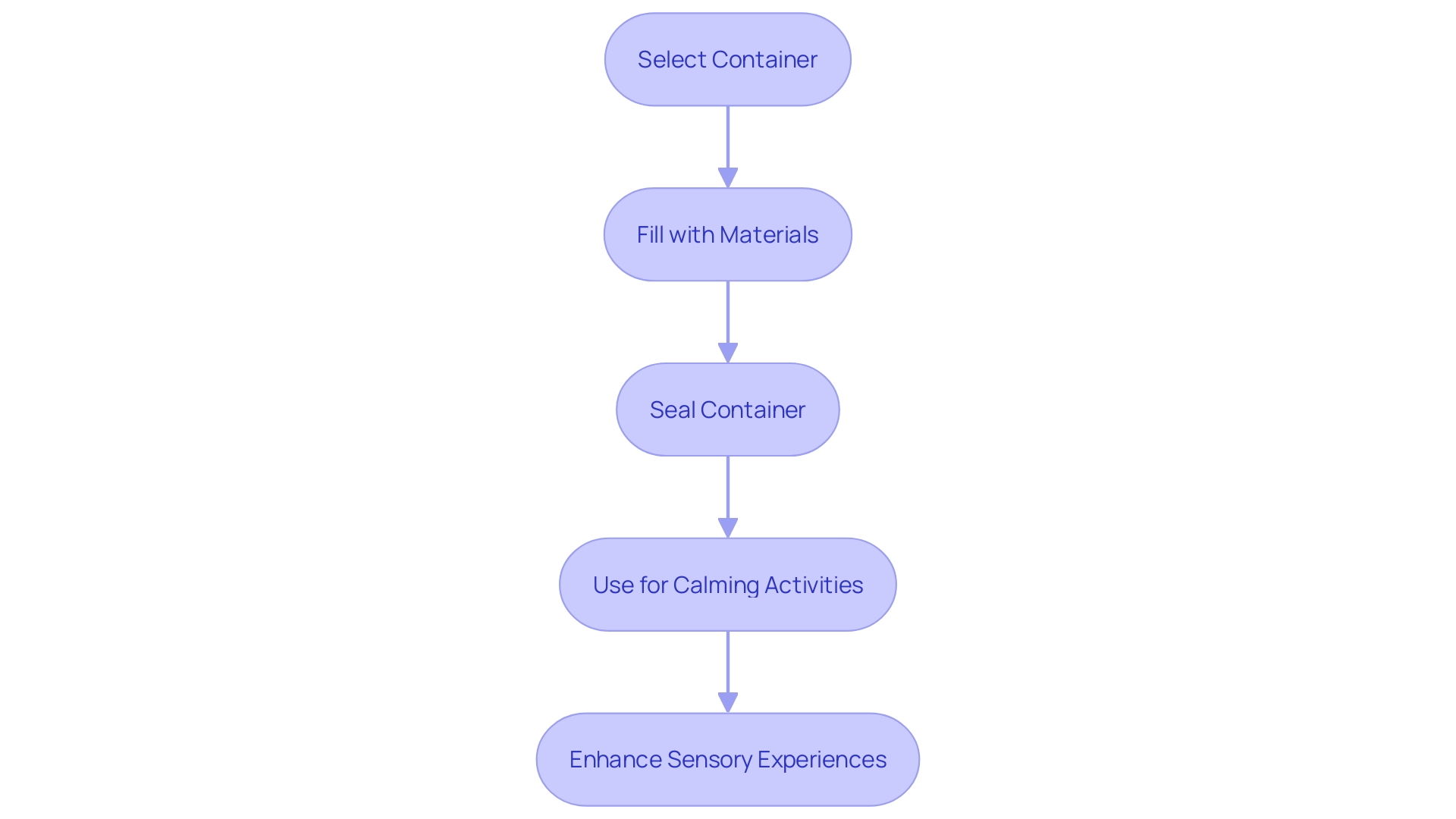
Ideas for Different Types of Sensory Bottles
Making sensory containers can be a delightful and enriching experience for children, providing both calming effects and opportunities for sensory exploration. Here are some imaginative ideas to inspire your creations:
- Ocean Bottle: Transform a simple bottle into a mesmerizing underwater scene by filling it with blue water, tiny shells, and fish toys. Watching the contents swirl and settle can evoke the tranquility of the ocean.
- Winter Wonderland: Capture the magic of winter by using white glitter, snow-like fillers, and artificial snowflakes. This container not only appears captivating but can also function as a calming sight during cold months.
- Nature Container: Collect items from the great outdoors, such as leaves, twigs, and small stones, to create a nature-themed experience. This promotes a connection to nature and can be a great conversation starter about the environment.
- Color Mixing Experiment: Introduce a fun science aspect by using different colored liquids. Children can experiment with mixing colors, observing how they blend and create new shades, which can enhance their understanding of color theory.
These tactile containers not only assist in soothing youngsters, particularly those who may face sensory overwhelm, but they also promote imagination and discovery, making them essential resources in a person's growth journey.
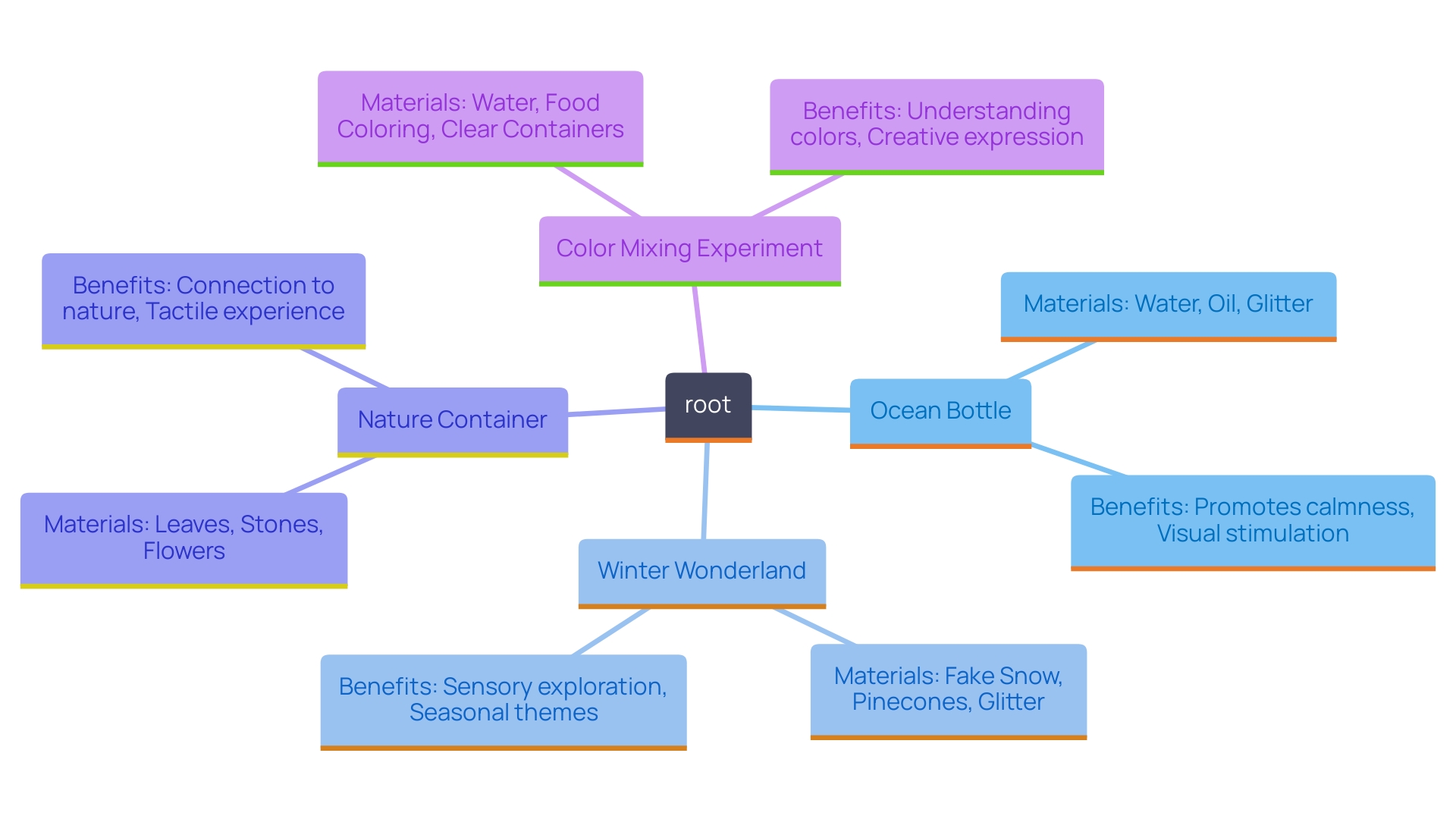
Safety Considerations and Adult Supervision
Making sensory containers can be a fun and rewarding activity for youngsters, but safety continues to be a primary concern. Always supervise the activity to ensure a safe and fun environment. When choosing substances for sensory containers, prioritize non-toxic choices that are safe for kids to handle. Regularly inspect the bottles for any signs of wear, leaks, or damage that could pose a risk during play. If you're incorporating small items like beads or glitter, be particularly cautious, as these can present choking hazards for younger individuals. Ensuring adult supervision during playtime allows youngsters to explore the surrounding world safely, promoting their growth while keeping them secure.
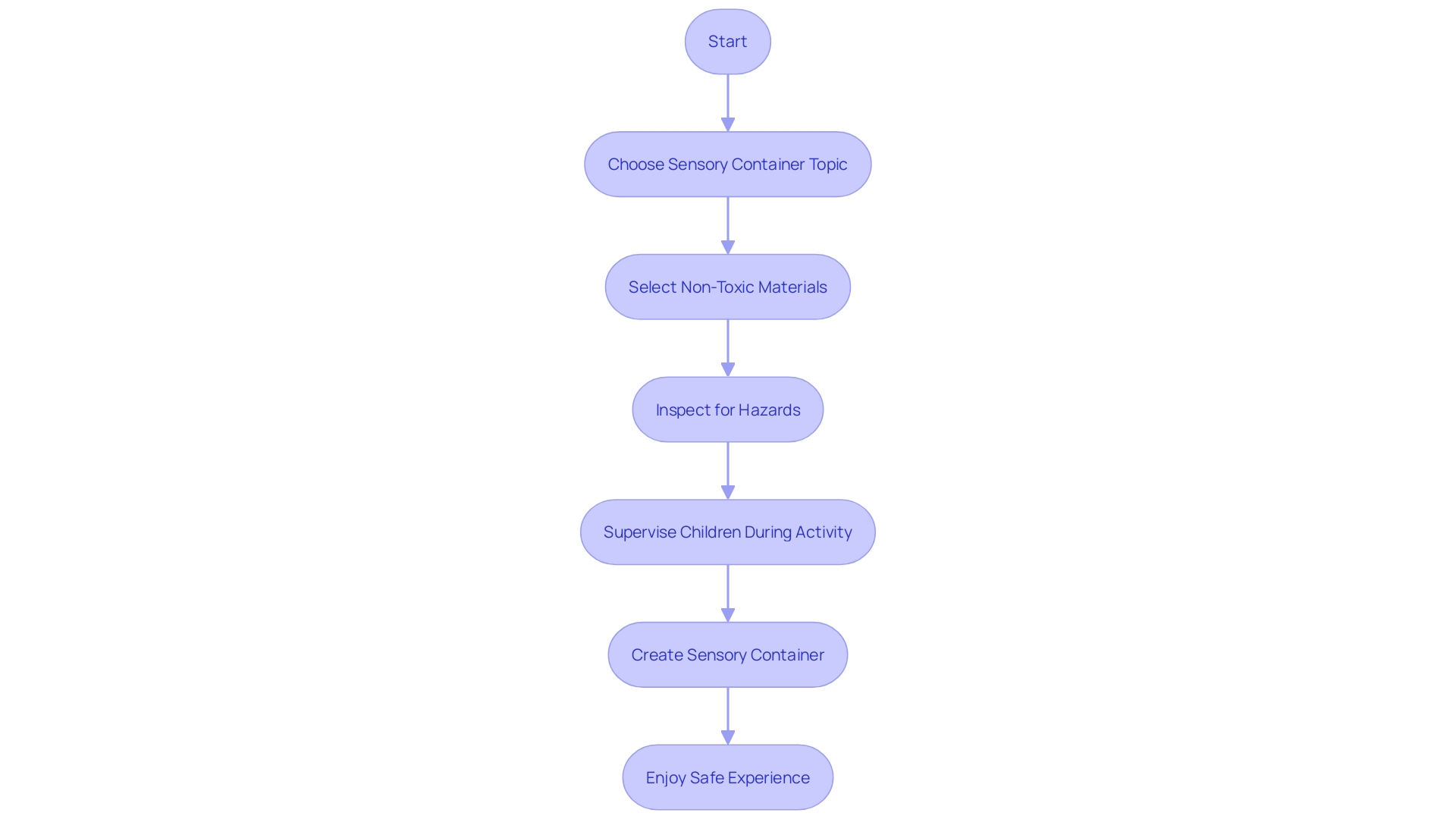
Tips for Customizing Sensory Bottles for Different Ages and Needs
Making tactile containers is an interesting and beneficial task that can address the growth phases and personal likes of youngsters. For younger individuals, it’s advantageous to include larger, more manageable items that they can easily grasp and manipulate. This not only aids in their fine motor development but also enhances their tactile experiences. For older kids, introducing intricate elements such as tiny beads or various textures can stimulate their curiosity and promote exploration.
The adaptability of these bottles enables you to customize the contents depending on whether your little one desires soothing or exciting experiences. Studies show that experiential tasks involve various senses—including touch, sight, and sound—and can greatly enhance language abilities, motor functions, and self-control skills. Exercises related to perception have been shown to 'sync-up' a child's sensory system, ultimately strengthening neural pathways in the brain.
For example, one parent recounted their experience: "For over five years now, I have been including sensory-friendly tasks into nearly every one of our days.". The benefits have been at the very least, noticeable and at best, life-changing." This emphasizes the significant effect that sensory experiences can have on education and emotional health, making sensory containers not just an enjoyable project, but a strong instrument for improving concentration and calmness.
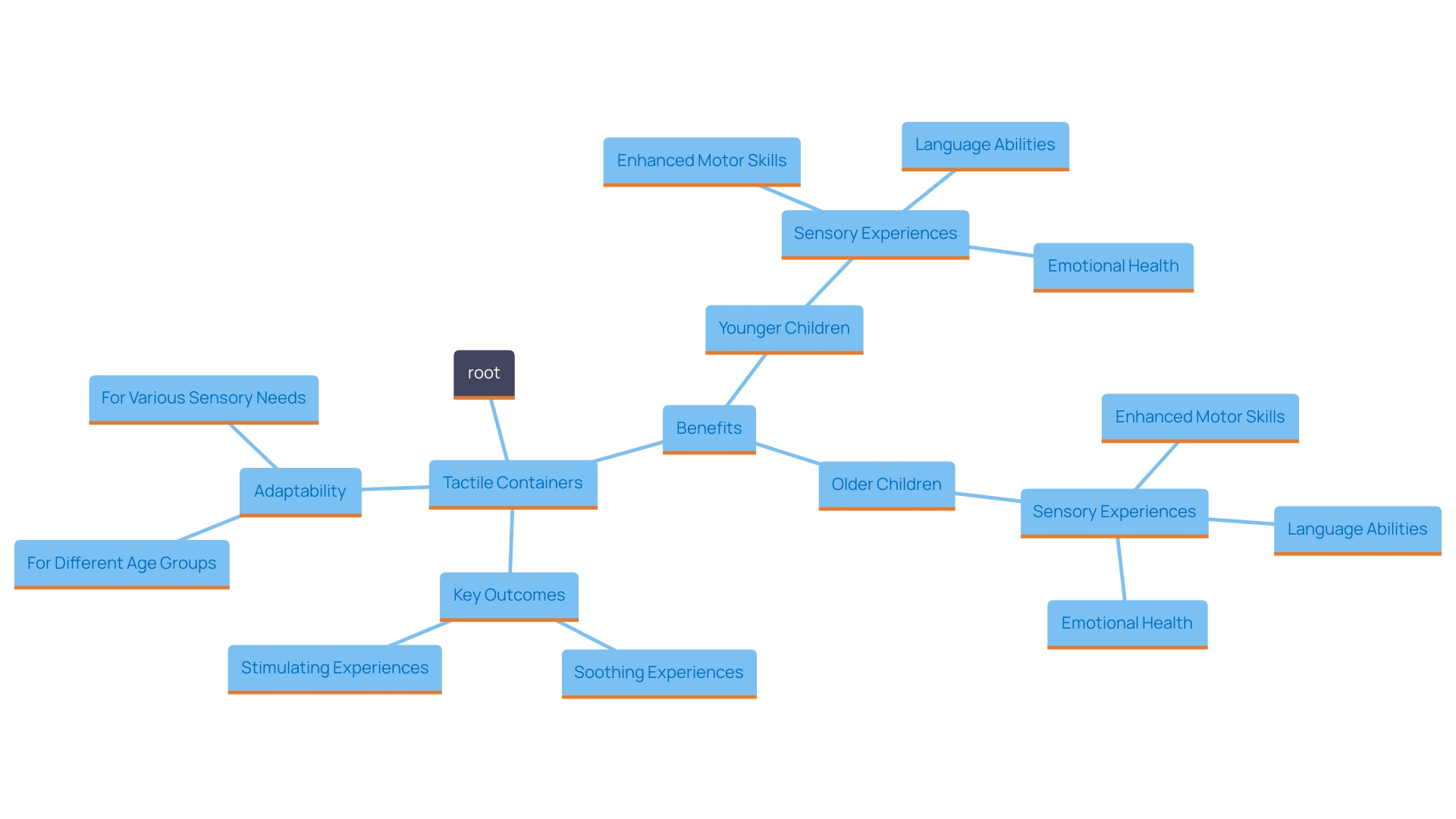
Using Sensory Bottles for Learning and Development
Sensory containers can play a crucial role in enhancing learning experiences for young ones. They function as adaptable instruments for different educational activities, such as counting games and color recognition exercises, enabling young learners to interact with concepts in a tactile and visual way. For example, by adding various colored liquids or glitter in a sensory container, youngsters can practice color recognition while also improving their fine motor abilities as they handle the container.
Moreover, these containers are not just educational tools; they also provide substantial calming advantages during transitions or times of stress. In dynamic environments that can often feel overwhelming—especially for individuals with ADHD or autism—sensory bottles provide a soothing focal point. This enables young individuals to practice self-regulation and mindfulness, essential skills for emotional well-being. Research shows that interactive experiences have a beneficial effect on self-discipline and interpersonal abilities, rendering them essential for holistic growth. As one parent observed, "Engaging in these activities aids in not only soothing and 'syncing-up' a young person's system, it also fortifies the brain’s neural pathways and connections."
Including tactile containers in activities not only boosts involvement but also encourages richer educational experiences. When young ones engage with these containers, they are not simply having fun; they are enhancing cognitive and motor abilities that will benefit them during their learning experience. As research indicates, play is essential for academic involvement, making engaging containers a fun yet effective educational resource.
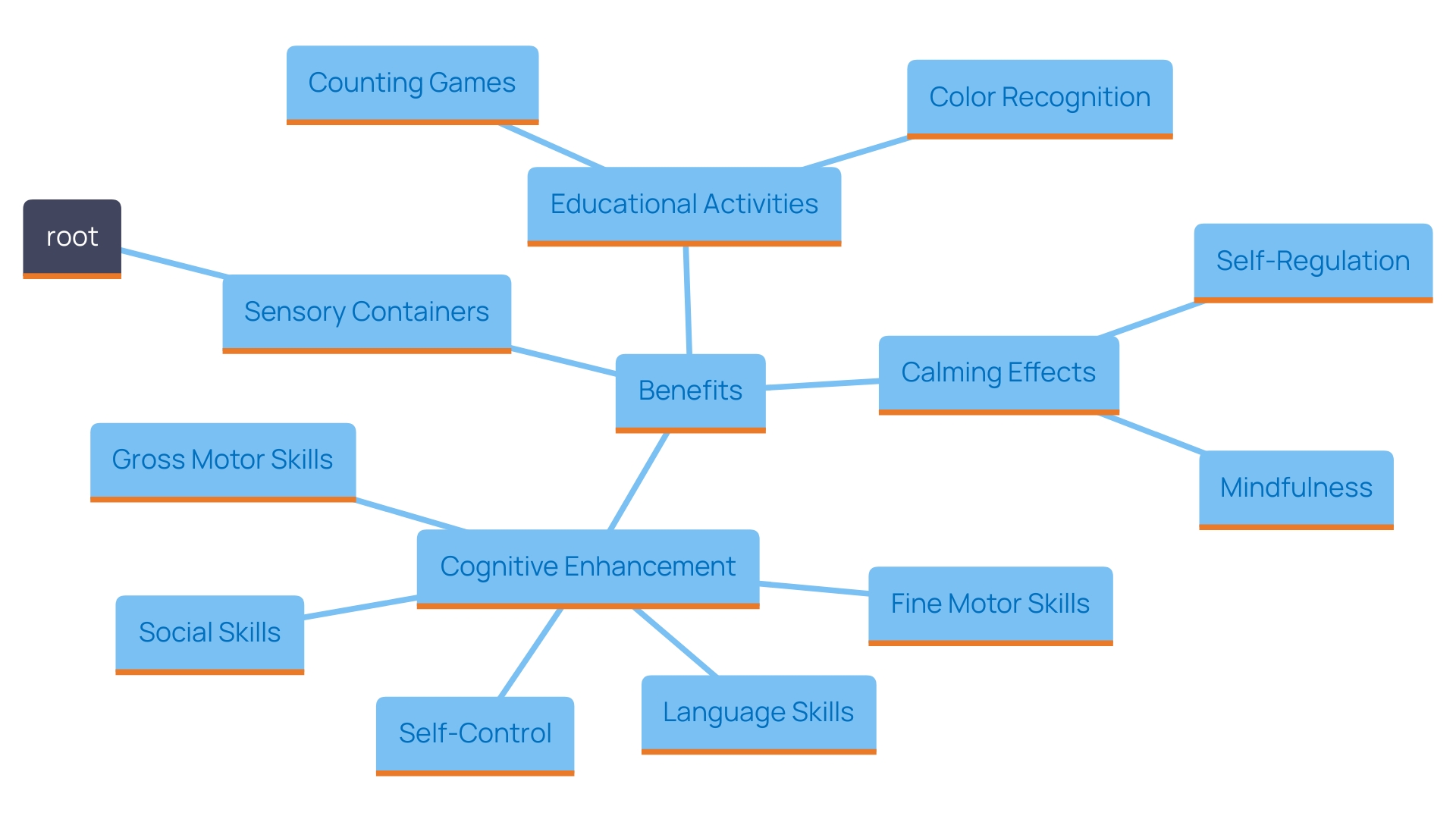
Creative Ways to Extend Sensory Bottle Activities
Converting tactile containers into engaging activities can greatly improve youngsters' involvement and educational experiences. One innovative approach is to create a scavenger hunt where children search for specific objects within the containers. This not only promotes observation and critical thinking but also introduces an element of excitement to the exploration process involving the senses.
Integrating sensory containers into art projects can further stimulate creativity. Children can be encouraged to create stories inspired by the different textures and colors they notice within their containers, fostering imaginative play and narrative skills. For example, a container filled with glitter and beads could inspire a tale of a magical forest or an underwater adventure.
Additionally, merging various kinds of bottles can produce a multi-faceted experience that encourages the exploration of different stimuli. Involving various senses—sight, sound, and touch—can enhance the soothing effects these pursuits have on young individuals. Studies indicate that sensory experiences beneficially influence language abilities, fine and large motor skills, and self-control, establishing them as essential resources in fostering a young person's growth.
As highlighted by specialists in the area, integrating sensory-friendly experiences into everyday practices can result in significant advantages in young individuals' learning and emotional health. These activities not only calm children but also help strengthen neural connections in the brain. Thus, sensory bottles serve as more than just fun; they are an essential resource for enhancing focus and promoting relaxation, making them perfect for both at-home play and educational settings.
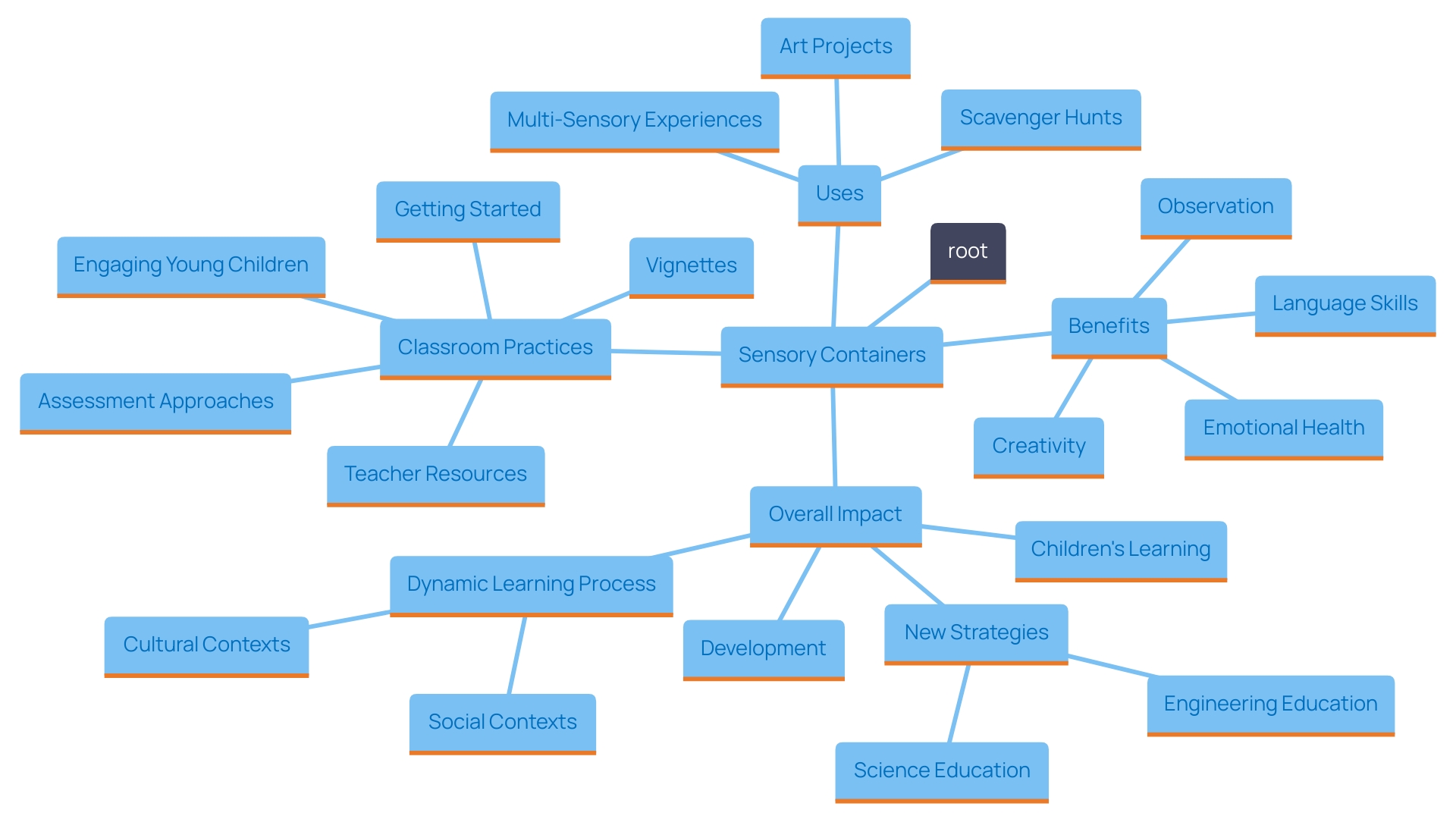
Conclusion
Sensory bottles are more than just engaging activities; they are essential tools for fostering emotional well-being and developmental growth in children. Their multifaceted benefits, particularly for those facing sensory processing challenges, highlight their role in reducing anxiety and promoting self-regulation. By captivating children's attention through a blend of textures, colors, and sounds, sensory bottles support focus and calmness, making them invaluable resources for learning and exploration.
The process of creating sensory bottles not only encourages creativity but also enhances fine motor skills and cognitive development. By allowing children to choose their materials and customize their bottles, caregivers empower them to take ownership of their sensory experiences. This hands-on engagement is crucial in promoting language skills, social interaction, and emotional regulation.
As research indicates, integrating sensory activities into daily routines can lead to significant improvements in overall development, benefiting all children—not just those with sensory sensitivities.
Safety remains a priority when crafting sensory bottles, emphasizing the need for adult supervision and the use of non-toxic materials. Customizing these bottles to suit different ages and sensory needs ensures that they can effectively cater to individual preferences, further enhancing their positive impact. Whether used for calming moments, learning activities, or creative play, sensory bottles are transformative resources that support children's journeys toward emotional and cognitive development.
They serve as a beacon of support for both children and their caregivers, reinforcing the importance of sensory engagement in nurturing well-rounded, resilient individuals.




